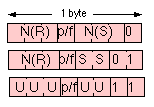
The control field of HDLC follows the address field and is the second part of all HDLC frames. The best-effort service is provided through the use of U (un-numbered) frames consisting of a single byte. All frames carry a field of size 1 bit which is known as the "poll/final" bit and is used by the checkpointing procedure to verify correct transmission.

Format of the control byte in HDLC frames
HDLC defines currently two formats for frames which carry sequence numbers. These type of frame are used to provide the reliable data link service. Two types of numbered frames are supported:
The S and U frames contain an additional field to identify the function which is to be performed. The 2-bit SS field is used to identify one of four functions:
The simplest format uses one byte (as above) and provides modulo 8 numbering. The "extended format" uses two bytes (as shown below) and uses modulo 128 numbering:

Format of the control byte in HDLC frames using an extended sequence number
Command and Response Addresses
In the HDLC balanced mode, the a node uses just two addresses (1 and 3) to indicate whether the frame relates to information frames (I-frames) being sent from the node or received by the node. The two values are known as "primary" and "secondary" addresses. The primary address is used for commands, (e.g. SABM, DISC, I). The secondary address is used for responses (e.g. UA, RR, REJ). The primary and secondary addresses are differentiated by the setting of the C/R bit in the HDLC Address.
Be-aware of transmission bit-order
Many books describing HDLC follow the ISO standard which defines the protocol. This describes the format of the HDLC control word according to the order in which the bits are transmitted at the physical layer. (i.e. least significant bit (lsb) transmitted first). To present a consistent view of all protocols, this course will describe the format in terms of the bit-order seen by the computer and used inside the computer network interface card. See separate section on bit order.